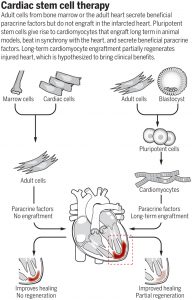In 2018, Charles E. Murry, MD, PhD, Professor and Director of the Center for Cardiovascular Biology and Chair at The University of Washington’s Institute for Stem Cell and Regenerative Medicine, gave a TEDx talk in Seattle. During the talk, he told the story of Donna, an active 70-year-old mother and grandmother. One day, she had severe pain and nausea and, instead of going to the hospital, went to bed and “rested” through the pain. A month later, her doctor diagnosed that she had lived through a massive heart attack. The damage from that heart attack eventually resulted in heart failure. Donna was Dr. Murry’s mother.
Motivated by this tragedy, Dr. Murry has conducted research for over twenty years to find a way to regenerate heart muscle that has been damaged using stem cells.
Types of Stem Cells
There are several types of stem cells. The one with the best ability to differentiate into different types of cells is pluripotent. Pluripotent stem cells are embryonic cells that have the capacity to become any of three lineages of cells, ectodermal, mesodermal and endodermal. Ectodermal lineage create for example: skin, neural tissue and teeth; mesodermal lineage produce bone, cartilage, blood and reproductive tissue while endodermal lineage form the organs of the gut, the liver, and thyroid gland to name a few.
Another type of stem cell is found in adults, called somatic stem cells. Stem cells from adults are found in many organs among differentiated cells and help with healing, growth and replacement of cells. They can differentiate into only one of the three types of cell lineage so they are referred to as multipotent stem cells.
Fraud in Stem Cell Research
Unfortunately over this same 20 year period that Dr. Murry was working, an unethical researcher named Piero Anversa falsified research. He and his research team claimed that adult stem cells from bone marrow and adult “cardio progenitor cells” were able to be used to create heart cells (cardiomyocytes) that regenerate heart muscle. No one was able to replicate this research. Over 30 publications had to be retracted. Anversa’s lab was closed and Partner’s Healthcare who runs Brigham and Women’s Hospital, where Anversa worked, paid the government $10 million in a settlement.1
One of the scientists who questioned the validity of Anversa’s work was Dr. Murry.2 In a Perspective letter to Science published last week,3 Murry writes about the losses caused by the fraudulent work but also provides ideas going forward with research using pluripotent stem cells. The notes from the powerpoint accompanying this image explain that,
“Adult cells from bone marrow or the adult heart secrete beneficial paracrine factors but do not engraft in the infarcted heart.[emphasis added] Pluripotent stem cells give rise to cardiomyocytes that engraft long term in animal models, beat in synchrony with the heart, and secrete beneficial paracrine factors. Long-term cardiomyocyte engraftment partially regenerates injured heart, which is hypothesized to bring clinical benefits.”
In the Science letter, Murry describes how using pluripotent stem cells that develop into cardiomyocytes as well human embryonic stem cell (hESC)-derived epicardial cells4 (the cells that help in building blood vessels to feed the heart) may be a next step in the process of regeneration of heart muscle with stem cell therapy.3 To learn more about his research, watch the TEDx presentation below.
References:
1 https://www.nature.com/articles/d41586-018-07232-0
2 https://www.nature.com/articles/s41587-019-0042-1
3 https://science.sciencemag.org/content/367/6480/854
4https://academic.oup.com/eurheartj/article/36/30/2011/2398140
Can stem cells help treat coronary artery disease and heart failure?
Feature Image Attribution: Cardiology by VM from the Noun Project








so is it out their for human’s ?
Brilliant work. I wish us the best.